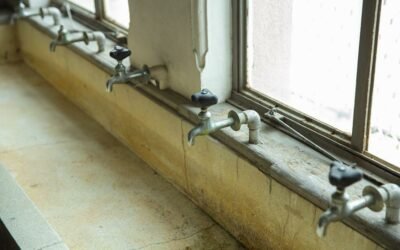Do you struggle with mold in your home? Discover how infrared technology can help you effectively kill mold.
In this article, we will explore the science behind infrared mold removal and discuss its pros and cons. You will also learn how to use infrared technology for efficient mold removal.
Say goodbye to mold and hello to a healthier living environment with the power of infrared.
Key Takeaways
- Infrared technology utilizes heat to target and eliminate mold.
- Infrared waves generate heat when they come into contact with surfaces, raising the temperature and killing the mold spores.
- Infrared technology is non-toxic and doesn't release harmful fumes or residues.
- It is important to combine infrared technology with other mold remediation techniques for effective mold removal.
What Is Infrared Technology
If you're wondering what infrared technology is, it can be defined as a method that uses electromagnetic radiation to detect and measure heat emitted by objects and organisms. Infrared radiation is a type of electromagnetic radiation with longer wavelengths than visible light. It isn't visible to the human eye but can be detected by specialized devices, such as infrared cameras or sensors.
Infrared technology works based on the principle that all objects emit heat in the form of infrared radiation. This radiation can be captured and converted into an image or temperature reading. By analyzing the intensity and distribution of infrared radiation emitted by an object or organism, infrared technology can provide valuable information about its thermal properties.
In addition to its use in temperature measurement, infrared technology has various applications in different fields. It's commonly used in thermal imaging cameras for night vision, security surveillance, and medical diagnostics. Infrared technology is also utilized in industries like agriculture, building inspection, and manufacturing, where it can help identify energy inefficiencies, detect leaks, and monitor processes.
Understanding the Growth and Dangers of Mold
To understand the growth and dangers of mold, it's important to recognize that mold can thrive in various environments. Mold is a type of fungus that reproduces through spores and can grow on various surfaces, including walls, ceilings, carpets, and even food.
Here are some key points to consider:
- Moisture: Mold requires moisture to grow, so areas with high humidity levels or water leaks are particularly susceptible. Bathrooms, kitchens, and basements are common areas where mold can flourish.
- Darkness: Mold prefers dark environments, making poorly lit areas more prone to its growth. Areas with limited ventilation or air circulation can also promote mold growth.
- Organic Materials: Mold feeds on organic materials such as wood, paper, fabric, and even dust. This is why mold growth is often found in buildings with water damage or excessive moisture.
- Health Risks: Mold can release spores and mycotoxins into the air, which can cause allergic reactions, respiratory issues, and other health problems. People with weakened immune systems or pre-existing respiratory conditions are more susceptible to these risks.
- Prevention and Removal: Controlling moisture levels, improving ventilation, and promptly addressing any water damage or leaks can help prevent mold growth. If mold is present, professional remediation may be necessary to ensure safe and thorough removal.
Understanding the growth and dangers of mold is crucial for maintaining a healthy living environment and preventing potential health risks.
The Science Behind Infrared Mold Removal
Infrared technology utilizes heat to target and eliminate mold, offering an effective solution for mold removal. The science behind infrared mold removal lies in how heat energy is used to disrupt the mold's cellular structure and ultimately destroy it. When infrared heat is applied to mold-infested areas, it penetrates the surface and raises the temperature to a level that's lethal to mold spores.
The process begins with the infrared equipment emitting infrared waves, which are a type of electromagnetic radiation with longer wavelengths than visible light. These waves generate heat when they come into contact with surfaces. As the heat is absorbed by the mold, it raises the temperature of the affected area, effectively killing the mold spores.
The effectiveness of infrared technology for mold removal lies in its ability to target the mold without causing damage to the surrounding materials. Unlike traditional methods like chemical treatments or abrasive scrubbing, infrared heat is non-toxic and non-invasive. It can reach into tight spaces and penetrate porous materials where mold often hides, ensuring a thorough treatment.
Furthermore, infrared mold removal is a safe and eco-friendly option. It doesn't involve the use of harsh chemicals or produce harmful byproducts. The heat generated by infrared technology also helps to dry out any moisture that may be contributing to the mold growth, preventing future infestations.
Pros and Cons of Using Infrared to Kill Mold
Using infrared technology to kill mold has its advantages and disadvantages. Here are some key points to consider:
- Efficiency: Infrared technology can quickly and efficiently eliminate mold by heating the affected area. It can penetrate deep into materials, reaching areas that may be difficult to access using traditional methods.
- Non-toxic: Unlike chemical treatments, infrared technology is non-toxic and doesn't release harmful fumes or residues. This makes it a safer option, especially in residential and sensitive environments.
- Preserves material integrity: Infrared technology doesn't require the use of harsh chemicals, which can damage the structure and integrity of materials. It can effectively kill mold while preserving the quality of the treated surface.
- Limited range: Infrared technology has a limited range and may not be suitable for large-scale mold infestations. It's best suited for localized areas or smaller spaces.
- Professional expertise: The use of infrared technology requires specialized knowledge and expertise. Professionals trained in using this technology can ensure its safe and effective application.
While infrared technology offers benefits such as efficiency, non-toxicity, and preservation of material integrity, its limited range and the need for professional expertise are important considerations. It's essential to assess the specific mold situation and consult with experts to determine the most appropriate solution.
How to Use Infrared Technology for Effective Mold Removal
Start by identifying the affected areas in your home or building. Infrared technology can be an effective tool for mold removal, but it's important to know how to use it properly. First, you need to conduct a thorough inspection of your property to locate any mold growth. Infrared cameras can help you identify hidden mold by detecting temperature differences caused by moisture and mold growth.
Once you have identified the affected areas, you can use infrared technology to target and eliminate the mold. Infrared heaters can be used to raise the temperature in the affected areas, creating an environment that's inhospitable to mold. The heat from the infrared heaters can penetrate walls, floors, and other surfaces, helping to kill mold spores and prevent regrowth.
It is important to note that infrared technology alone may not be enough to completely eliminate mold. It should be used in conjunction with other mold remediation techniques, such as proper ventilation, moisture control, and the removal of damaged materials. Additionally, it's crucial to address the underlying cause of the mold growth, such as a water leak or high humidity, to prevent future mold problems.
Conclusion
In conclusion, infrared technology has shown promise in effectively killing mold. By utilizing the heat generated by infrared waves, it can penetrate surfaces and target mold growth, eliminating the spores and preventing further spread.
However, it's important to consider the limitations and potential drawbacks of using infrared for mold removal, such as the need for professional equipment and expertise.
Overall, infrared technology can be a valuable tool in combating mold, but proper precautions and evaluation should be taken before use.






0 Comments